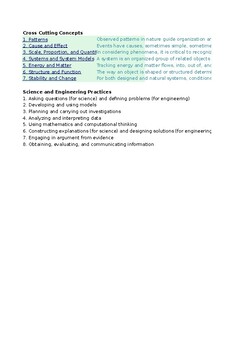Earth Science NGSS Lesson Plan Template
Qs Compendium
1 Follower
Grade Levels
9th - 12th
Subjects
Resource Type
Standards
NGSSHS-ESS2-5
NGSSHS-ESS1-6
NGSSHS-ESS2-3
NGSSHS-ESS2-1
NGSSHS-ESS1-4
Formats Included
- XLSX
Qs Compendium
1 Follower
Description
The Next Generation Science Standards come alive with three dimensional learning, and this format keeps those dimensions at the forefront of planning. This lesson plan spreadsheet allows for streamlined selection of NGSS Standards for each lesson as teachers plan weeks, units, and eventually the entire year.
With drop down menus for DCIs, CCCs, and SEPs, date upon a double click for relevant cells, and an easy to use google drive compatibility, teachers can plan ahead, keep track of progress, and provide evidence of professionalism on evaluations.
Total Pages
Answer Key
N/A
Teaching Duration
N/A
Report this resource to TPT
Reported resources will be reviewed by our team. Report this resource to let us know if this resource violates TPT’s content guidelines.
Standards
to see state-specific standards (only available in the US).
NGSSHS-ESS2-5
Plan and conduct an investigation of the properties of water and its effects on Earth materials and surface processes. Emphasis is on mechanical and chemical investigations with water and a variety of solid materials to provide the evidence for connections between the hydrologic cycle and system interactions commonly known as the rock cycle. Examples of mechanical investigations include stream transportation and deposition using a stream table, erosion using variations in soil moisture content, or frost wedging by the expansion of water as it freezes. Examples of chemical investigations include chemical weathering and recrystallization (by testing the solubility of different materials) or melt generation (by examining how water lowers the melting temperature of most solids).
NGSSHS-ESS1-6
Apply scientific reasoning and evidence from ancient Earth materials, meteorites, and other planetary surfaces to construct an account of Earth’s formation and early history. Emphasis is on using available evidence within the solar system to reconstruct the early history of Earth, which formed along with the rest of the solar system 4.6 billion years ago. Examples of evidence include the absolute ages of ancient materials (obtained by radiometric dating of meteorites, moon rocks, and Earth’s oldest minerals), the sizes and compositions of solar system objects, and the impact cratering record of planetary surfaces.
NGSSHS-ESS2-3
Develop a model based on evidence of Earth’s interior to describe the cycling of matter by thermal convection. Emphasis is on both a one-dimensional model of Earth, with radial layers determined by density, and a three-dimensional model, which is controlled by mantle convection and the resulting plate tectonics. Examples of evidence include maps of Earth’s three-dimensional structure obtained from seismic waves, records of the rate of change of Earth’s magnetic field (as constraints on convection in the outer core), and identification of the composition of Earth’s layers from high-pressure laboratory experiments.
NGSSHS-ESS2-1
Develop a model to illustrate how Earth’s internal and surface processes operate at different spatial and temporal scales to form continental and ocean-floor features. Emphasis is on how the appearance of land features (such as mountains, valleys, and plateaus) and sea-floor features (such as trenches, ridges, and seamounts) are a result of both constructive forces (such as volcanism, tectonic uplift, and orogeny) and destructive mechanisms (such as weathering, mass wasting, and coastal erosion). Assessment does not include memorization of the details of the formation of specific geographic features of Earth’s surface.
NGSSHS-ESS1-4
Use mathematical or computational representations to predict the motion of orbiting objects in the solar system. Emphasis is on Newtonian gravitational laws governing orbital motions, which apply to human-made satellites as well as planets and moons. Mathematical representations for the gravitational attraction of bodies and Kepler’s Laws of orbital motions should not deal with more than two bodies, nor involve calculus.





